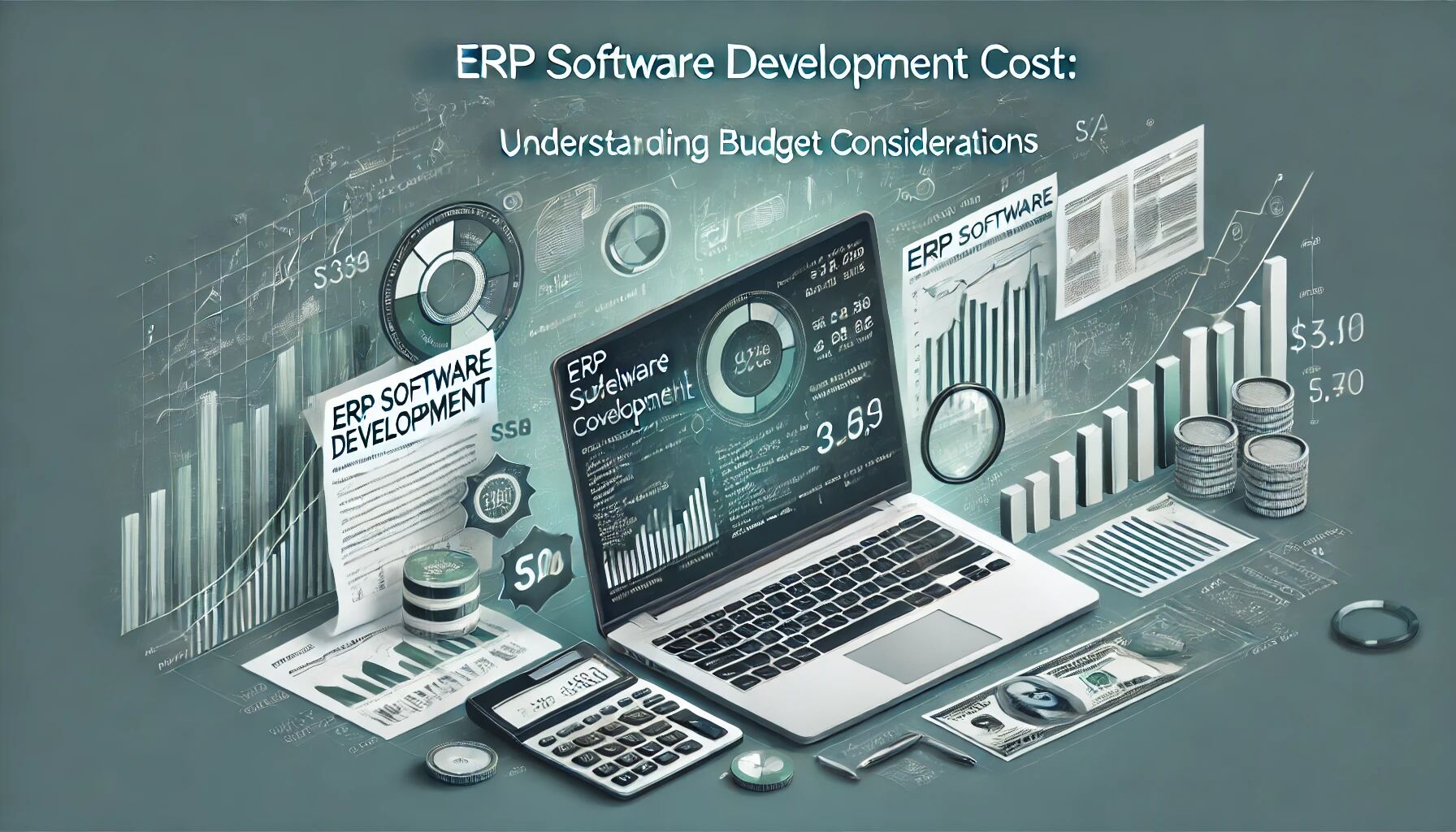
Introduction
Enterprise Resource Planning (ERP) systems integrate core business processes into a single platform, offering real-time data and insights crucial for decision-making. While the benefits of ERP systems are significant, understanding the costs involved in ERP software development is essential for budget planning and project success.
Factors Influencing ERP Software Development Costs
- Customization Requirements
The extent of customization required significantly impacts ERP software development costs. Businesses may opt for off-the-shelf ERP solutions with minimal customization or invest in custom ERP development tailored to specific industry needs and business processes. - Integration Complexity
Integration with existing systems and third-party applications adds complexity to ERP software development. The cost may vary based on the number of integrations required, data migration efforts, and ensuring seamless interoperability across platforms. - Software Licensing and Infrastructure
Consideration of software licensing fees, hardware infrastructure requirements (on-premise or cloud-based), and ongoing maintenance costs is crucial. Cloud-based ERP solutions often entail subscription-based pricing models, while on-premise solutions may incur higher initial setup costs. - Implementation and Training
Budget for implementation services, including project management, configuration, testing, and user training. Adequate training ensures effective adoption of ERP systems by end-users, maximizing return on investment (ROI). - Support and Maintenance
Factor in ongoing support and maintenance costs post-implementation. This includes software updates, troubleshooting, helpdesk support, and potential upgrades to accommodate evolving business needs and regulatory changes.
Cost Estimation Strategies
- Requesting Proposals: Obtain detailed proposals from ERP vendors or development firms, outlining itemized costs for development, implementation, training, and ongoing support.
- ROI Analysis: Conduct a cost-benefit analysis to evaluate the potential ROI of ERP implementation against initial and recurring costs. Consider long-term benefits such as improved efficiency, reduced operational costs, and enhanced decision-making capabilities.
Conclusion
ERP software development costs vary based on customization requirements, integration complexity, software licensing, infrastructure, implementation, training, and ongoing support. By understanding these cost factors and implementing effective budgeting strategies, businesses can successfully deploy ERP systems that streamline operations and drive business growth.
Final Thoughts
Investing in ERP software development involves strategic planning and financial preparedness. By aligning budget considerations with organizational goals and leveraging the expertise of ERP development partners, businesses can navigate the complexities of ERP implementation and maximize the value derived from their investment.






купить дипломы о среднем образовании срочно купить дипломы о среднем образовании срочно .
где купить диплом о высшем образовании цена russa-diploms.ru .
Приобретение диплома ПТУ с сокращенной программой обучения в Москве
купить диплом бакалавра в нижнем новгороде man-diploms.ru .
куплю диплом о высшем образовании читать prema-diploms.ru .
Официальное получение диплома техникума с упрощенным обучением в Москве
купить диплом высшее в омске man-diploms.ru .
купить диплом педагога купить диплом педагога .
Быстрая схема покупки диплома старого образца: что важно знать?
купить диплом цены купить диплом цены .
Как правильно купить диплом колледжа и ВУЗа в России, подводные камни
Аттестат школы купить официально с упрощенным обучением в Москве
Всё о покупке аттестата о среднем образовании: полезные советы
erudio.global/blog/index.php?entryid=38944
можно ли купить аттестат можно ли купить аттестат .
где купить аттестат где купить аттестат .
Приобретение диплома ВУЗа с сокращенной программой обучения в Москве
купить диплом о среднем в тюмени man-diploms.ru .
купить диплом средней специальности orik-diploms.ru .
ли купить диплом вуза server-diploms.ru .
купить диплом о высшем образовании сколько стоит купить диплом о высшем образовании сколько стоит .
купить диплом о высшем образовании липецк купить диплом о высшем образовании липецк .
купить диплом техника купить диплом техника .
образование купить диплом какие server-diploms.ru .
Можно ли купить аттестат о среднем образовании, основные моменты и вопросы
купить диплом с занесением в реестр в калуге man-diploms.ru .
Быстрое обучение и получение диплома магистра – возможно ли это?
Как официально купить аттестат 11 класса с упрощенным обучением в Москве
Полезные советы по безопасной покупке диплома о высшем образовании
купить диплом о среднем образовании официальный 2orik-diploms.ru .
купить диплом в нижним тагиле prema365-diploms.ru .
Сколько стоит получить диплом высшего и среднего образования легально?
Приобретение диплома ПТУ с сокращенной программой обучения в Москве
купить диплом магнитогорск prema365-diploms.ru .
Процесс получения диплома стоматолога: реально ли это сделать быстро?
Узнайте, как безопасно купить диплом о высшем образовании
Как избежать рисков при покупке диплома колледжа или ПТУ в России
Парадокс, но купить диплом кандидата наук оказалось не так и сложно
Сколько стоит диплом высшего и среднего образования и как его получить?
диплом о среднем специальном образовании с занесением в реестр диплом о среднем специальном образовании с занесением в реестр .
Приобретение диплома ПТУ с сокращенной программой обучения в Москве
Купить диплом старого образца, можно ли это сделать по быстрой схеме?
Как получить диплом техникума с упрощенным обучением в Москве официально
Диплом пту купить официально с упрощенным обучением в Москве
Официальная покупка диплома вуза с упрощенной программой обучения
Всё о покупке аттестата о среднем образовании: полезные советы
Всё, что нужно знать о покупке аттестата о среднем образовании без рисков
Как получить диплом техникума с упрощенным обучением в Москве официально
Как приобрести аттестат о среднем образовании в Москве и других городах
Пошаговая инструкция по официальной покупке диплома о высшем образовании
Покупка диплома о среднем полном образовании: как избежать мошенничества?
Официальное получение диплома техникума с упрощенным обучением в Москве
Парадокс, но купить диплом кандидата наук оказалось не так и сложно
Как купить аттестат 11 класса с официальным упрощенным обучением в Москве
Как избежать рисков при покупке диплома колледжа или ПТУ в России
Вопросы и ответы: можно ли быстро купить диплом старого образца?
Можно ли купить аттестат о среднем образовании, основные моменты и вопросы
Всё, что нужно знать о покупке аттестата о среднем образовании без рисков
Как приобрести аттестат о среднем образовании в Москве и других городах
yeni deneme bonusu veren siteler: deneme bonusu veren yeni siteler – deneme bonusu veren siteler yeni
en iyi bahis sitesi hangisi https://sweetbonanza25.com/# sweet bonanza guncel
en yeni bet siteleri
az parayla cok kazandiran slot oyunlar?: guvenilir slot siteleri – guvenilir slot siteleri
bilinmeyen bahis siteleri